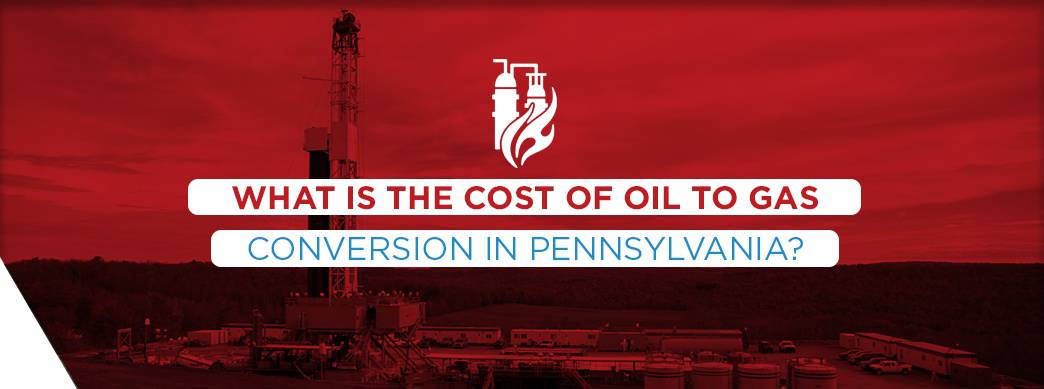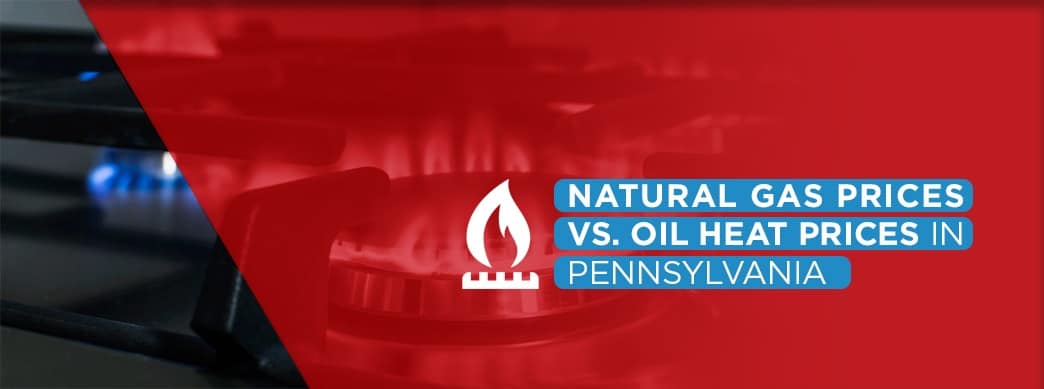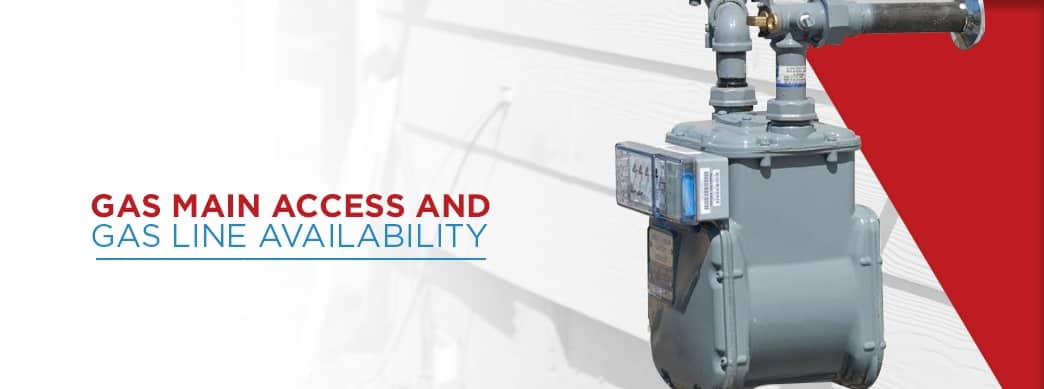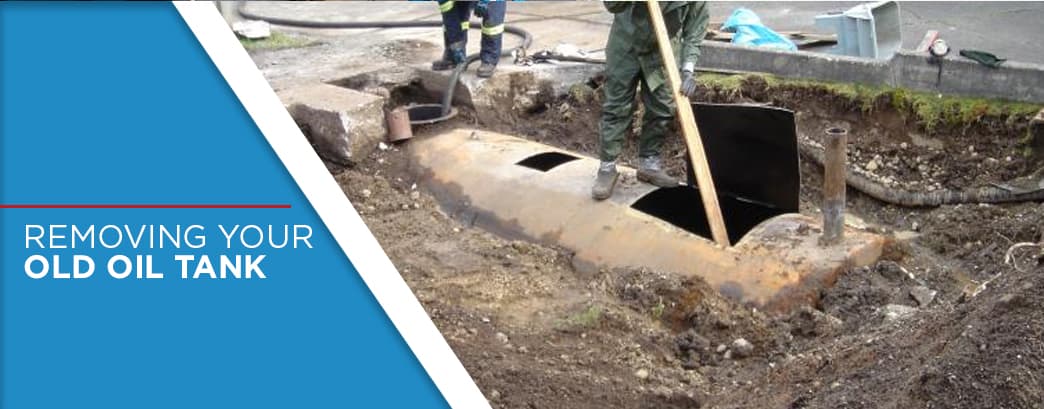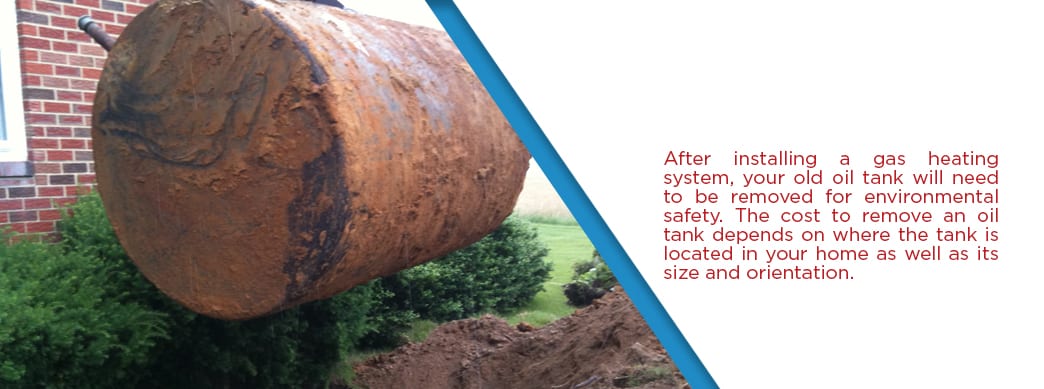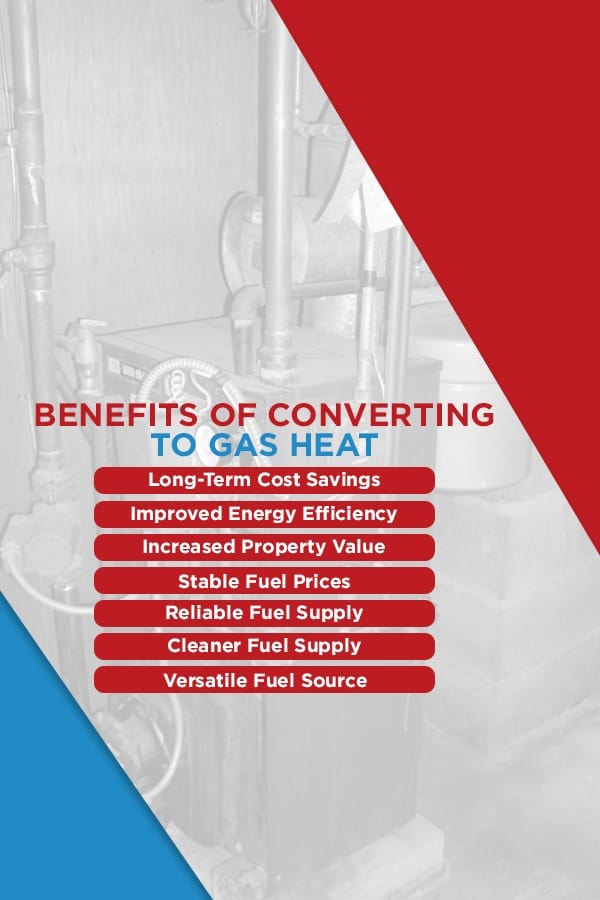If you are considering switching to natural gas, you probably already know that heating your home with gas can lower your heating costs and increase the energy efficiency of your home — while also supporting U.S. energy production and reducing your carbon footprint. With more homeowners in the Northeast switching from oil to gas every year, converting your home to gas heat may seem like the obvious choice. But if you are still weighing the costs and benefits of a natural gas conversion, Home Climates can help.
In this article, we will break down all of the costs involved with converting your home heating system from oil to gas so you can make the right decision for your home.
Natural Gas Prices vs. Oil Heat Prices in Pennsylvania
One of the main reasons that many homeowners are switching to natural gas is its lower operating costs. Compared to oil, heating your home with gas can save hundreds of dollars each year. In Pennsylvania, over 50 percent of households already use natural gas as the primary fuel to heat their homes, while only 17 percent rely on oil.
However, the Northeast still has the highest concentration of homes that use oil as their primary heating fuel. Out of the 464 trillion Btu of fuel oil consumed in the U.S. annually, 395 trillion Btu are consumed in the Northeast region — with 209 trillion Btu consumed in New England and 186 Btu consumed in the Middle Atlantic region each year. Many older homes in Pennsylvania and surrounding states were built during a time when oil was an affordable home heating fuel. However, oil prices have risen in past years and also fluctuate greatly throughout the year. Natural gas has now become a more cost-effective and stable fuel source.
When you compare oil heat prices with natural gas heat prices, it is clear why so many people are making the switch. Propane gas heat prices are also significantly lower than oil. Here are the average annual energy expenditures for oil, propane and natural gas as reported in the 2015 Residential Energy Consumption Survey (RECS) from the U.S. Energy Information Administration (EIA):
- Natural gas: $749 annually per household
- Propane: $866 annually per household
- Fuel oil or kerosene: $1,169 annually per household
When looking at the entire country, the difference between the cost of heating your home with oil or natural gas becomes even more striking. Nationally, the average annual energy cost for fuel oil was $1,206 annually per household while natural gas was only $596 per household each year.
How to Convert From an Oil to a Gas Heating System
Switching to natural gas or propane can significantly reduce your monthly heating bill and annual heating expenses. However, the cost of converting your heating system to natural gas can still be a fairly large investment in some areas, especially if your home does not have easy access to a gas main or gas line.
One of the first steps to deciding if switching from oil to gas is right for your home is determining what types of fuel are available in your area. Unlike oil and propane which are delivered to your home by truck or purchased in tanks, natural gas is piped directly into your home through a gas line. This gas line connects to a gas main which is buried underground and stores a large volume of natural gas.
Central PA Oil to Gas Conversions
Even in regions with a high concentration of oil-heated homes, most neighborhoods now have a gas main that can supply natural gas to the surrounding homes. However, if you live in a more remote area, accessing the nearest gas main may be challenging or expensive.
Depending on what kind of fuel is already available in your area, here are a few different steps you may need to take to switch over to a gas heating system in your home:
- Install a gas main: If your neighborhood does not have a gas main, you will need to contact your local utility company to install one. If enough of your neighbors are also interested in making the switch to natural gas, you may be able to convince your neighborhood to add a gas main.
- Install a gas line: If your street already has a gas main, you can convert your home to a natural gas heating system by adding a gas line that connects the gas main to your home. If you live in an urban or suburban area, your home may already have a gas line without you knowing. To check if your home has a gas line, look for a gas meter, which is typically located on the outside of your house.
- Install a gas furnace: Once you have connected a gas line to your home or if your home already has a gas line, you simply need to install gas-fired heating appliances and remove your old oil tank. Depending on the type of furnace you choose and the associated labor costs, this can be a reasonably affordable conversion.
If your neighborhood does not have a gas main or you live in a remote area and are unable to install a gas main or gas line, propane can be a good alternative. Propane gas is a more affordable heating fuel than oil and also burns hotter than oil, making it a more efficient heating fuel. Propane is delivered to your home in tanks, making it a viable option for homes that cannot access a gas main.
What is the Average Cost to Convert from Oil to Gas and Factors That Influence Costs
The average cost of converting your home heating system to natural gas can range widely, depending on a whole host of factors. Where you live, your home’s current heating system and who you choose as your HVAC contractor all impact the overall cost of converting your home to gas heat. Once you have determined that natural gas is available in your area, you can begin calculating the oil-to-gas conversion costs for your home.
Here are some of the main factors that impact the cost of conversion from oil to natural gas heat in your home:
1. Gas Main Access and Gas Line Availability
If your home does not have a gas line, you will need to install one before getting a new gas furnace. The cost of installing a gas line includes the cost of the materials and the labor required to lay the gas line. Gas lines are priced by linear foot and can cost anywhere from less than a dollar per foot up to $8 per foot, depending on the type of material.
Including labor, this price may go up to around $20 per foot for a basic installation. In a basic installation, your utility company will dig a trench and lay the pipe in a straight line to connect to your home. Some utility companies use trenchless technology that does not require any digging to run the gas line for a basic installation. If your installation is more complicated or involves digging underneath an existing driveway or structure, the labor costs could be much higher.
In some neighborhoods, your local utility will install a gas line for free if it only needs to be run a short distance or if several of your neighbors already use gas. In rural areas, they may cover the costs of running a gas line to the edge of your property, but you may have to pay for the rest of the installation.
When connecting a gas line to your home, you may also have to pay for installing a gas meter and gas shut-off valve. Residential gas meters range from $100 to $300 including labor for installation, and a gas shut-off valve could cost an additional $300 to $500 including labor. Utility companies sometimes offer payment plans that allow you to spread the installation payment over a few months or years.
2. Updating Your Heating Appliances
When converting your home to gas heat, you will need to install a gas furnace and other gas-fired heating appliances. The cost of converting your appliances to gas will depend on the type of system you choose, the size of the system and your HVAC contractor. The cost of installing an 80,000 Btu furnace for an average-sized home of 1,600 to 2,000 square feet ranges from about $3,500 to $6,500, depending on the brand of furnace that you choose.
During installation of your gas furnace, your contractor will run piping to connect your gas line and gas meter to your heating appliance. This may be an additional charge of a few hundred to a thousand dollars. If you choose a trustworthy HVAC contractor, they will provide all of these costs upfront so you are not surprised during installation.
While spending a few thousand dollars for a new gas furnace may sound expensive, installing an oil furnace typically costs much more. Installing an oil furnace for heating an average-sized home ranges from about $4,500 to $7,500.
Some homeowners who have a newer oil furnace may also have the option to convert their existing oil appliances to natural gas using a conversion burner. A conversion burner replaces only the oil burner and eliminates the need to install an entirely new gas furnace. This option is typically available for oil furnaces that are less than 10 years old and can save homeowners significantly— the equipment and installation cost for a conversion burner ranges from $3,200 to $3,600.
3. Removing Your Old Oil Tank
After installing a gas heating system, your old oil tank will need to be removed for environmental safety. The cost to remove an oil tank depends on where the tank is located in your home as well as its size and orientation. Oil tanks that are underground are typically the most expensive to remove and can cost up to $2,500. Basement oil tank removal is typically around $1,000, while removing an above ground tank may cost as little as $400. Tanks that are oriented horizontally usually cost less to remove than vertically-oriented tanks.
4. Installing a Chimney Liner
In some homes, it may be necessary to install a chimney liner when converting to gas heat. Oil heating systems can deposit sulfur in the chimney which can deteriorate the chimney lining when combined with the combustion gases. Over time, this produces small cracks in the chimney which can allow dangerous gases to enter your home. When switching to gas, installing a chimney liner will ensure your home stays safe and healthy.
Chimney liners are available in several different types, including clay, aluminum and stainless steel. More expensive chimney liners involve pouring a ceramic or cement-like mixture into the chimney, which fills in cracks and crevices for an effective seal. Here are some estimated prices for different chimney liners:
- Clay tiles: About $10 per foot
- Aluminum: About $12 per foot
- Stainless steel: About $65 per foot
- Thermocrete (ceramic poured-in-place liner): About $200 per foot
- Cast-in-place (cement-like liner): About $250 per foot
Stainless steel is the most popular type of chimney liner and is often recommended by HVAC contractors. Stainless steel chimney liners provide lasting durability and an excellent fire rating for improved safety. Stainless steel chimney liners are available in flexible or rigid forms and are safe for use with gas, oil or wood-burning appliances, while aluminum is only suitable for medium-efficiency gas appliances.
When calculating the overall cost of converting to natural gas, talk with your local utility and HVAC contractor. They can assess the work that will need to be done to upgrade your home heating system and can provide accurate estimates for installing gas heat in your home.
Benefits of Converting to Gas Heat
While the cost of converting to gas can be hefty, there are also numerous benefits to switching that can outweigh the costs in the long run. These benefits can put money back in your pocket, as well as offering greater convenience and supporting the U.S. economy. Here are some of the benefits of switching to natural gas:
1. Long-Term Cost Savings
As mentioned above, enjoying a lower monthly heating bill is one of the primary motivations for switching to gas heat. Natural gas is a more efficient heating fuel than oil, meaning you do not have to use as much to keep your home warm in the winter. Based on data from the 2015 RECS, in the Middle Atlantic region, you could save over $400 per year when you switch from oil heat to gas heat. If you choose a highly energy-efficient natural gas furnace, your savings could be even greater.
Another benefit of switching to natural gas is that you will be billed based on your actual fuel consumption. You never have to prepay for natural gas as you may with oil and have better control over your monthly heating bill.
2. Improved Energy Efficiency
If your home’s heating system is relatively old, your furnace may only be 55 to 70 percent efficient. This means you are spending a lot of money on wasted fuel. Upgrading to a new heating system can greatly boost the energy efficiency of your home and save you money.
Gas furnaces also tend to be more energy-efficient than oil heaters. When your heating system is more efficient, you can use less fuel and save even more money. In the Northeast, homes heated by oil consume about 73 million Btu annually, while homes heated with natural gas consume 68.7 million Btu each year. Energy-efficient gas heaters also require very little maintenance to continue running smoothly for years to come.
3. Increased Property Value
Converting your heating system to natural gas can also increase your property value. If you choose to sell your home in the future, an energy-efficient natural gas heating system can boost your resale value. Homebuyers know the importance and value of an efficient heating system and the lower monthly heating costs that come with it. Investing in a new gas heating system can increase the value of your home and help it stand out in a crowded market.
4. Stable Fuel Prices
Because natural gas is produced domestically, natural gas prices tend to be more stable than oil prices. In their Short-Term Energy Outlook for 2019, the EIA predicts that Henry Hub natural gas prices will remain fairly stable through 2020. Dry U.S. natural gas production is also expected to continue to grow in the next two years and outpace domestic consumption. This growth may also help to keep natural gas prices low and stable for U.S. homeowners.
5. Reliable Fuel Supply
Natural gas is piped directly into your home, meaning you never have to worry about running out of heating fuel. When you heat your home with oil, you could get caught in the cold if you forget to schedule your oil tank to be refilled. In Pennsylvania, severe winter weather can also be a concern for your heating supply. If you fail to plan ahead, you could run out of heating oil during a storm and not be able to refill your tank or be forced to pay a hefty fee for an emergency delivery. When you switch to natural gas, you can rest easy knowing your home will always have heating fuel.
6. Cleaner Fuel Supply
Switching to natural gas heat can also reduce your home’s carbon footprint. Natural gas has lower carbon emissions and burns cleaner than any other type of fossil fuel. By converting from oil to gas heat, you are doing a favor for the environment as well as your wallet.
7. Supports National and Local Energy Production
When you heat your home with natural gas, you are supporting U.S. energy production. Nearly all of the natural gas consumed in the U.S. is produced domestically, meaning making the switch to gas heat can help lower our country’s dependence on foreign oil.
In addition to supporting the national economy, switching to natural gas also has a local impact. Pennsylvania has the second highest natural gas production of any state, and in 2017, Pennsylvania accounted for 19 percent of the marketed natural gas production in the U.S. As the natural gas industry in Pennsylvania continues to grow, it creates more jobs in our state and boosts the local economy.
8. Versatile Fuel Source
Heating your home with natural gas also opens the doors for additional home upgrades and improvements. Natural gas is a versatile fuel source that can be used to power your heat, hot water, clothes dryer, hot water, clothes dryer, outdoor grill, new gas stove, indoor fireplace or space heater for your basement. You can even use natural gas to power your porch lighting or heat your swimming pool. When you switch to efficient natural gas, you will also enjoy lifestyle improvements on a daily basis as your clothes can dry faster and you will rarely run out of hot water.
Contact Home Climates for Your Free Estimate and Consultation
Each year, more Pennsylvania residents are making the switch to natural gas to reduce their yearly heating expenses. If you are considering converting your home from oil to gas, Home Climates can provide a free in-home estimate and consultation. As a licensed HVAC contractor serving central Pennsylvania, we can provide a thorough assessment of your home to help you decide if switching to natural gas is the right choice for you.
Central PA Oil to Gas Conversions
When you are ready to make the switch, Home Climates can install your new natural gas appliances at an affordable rate. We offer upfront flat-rate pricing so you can choose the right gas furnace for your budget and home heating needs. If your home has a younger oil furnace, Home Climates may also be able to install a conversion burner for a more affordable oil-to-gas conversion. Our flexible financing options make it even easier to invest in an oil-to-gas conversion for your home. Learn more about oil-to-gas conversion services from Home Climates or contact us today for your free estimate.









